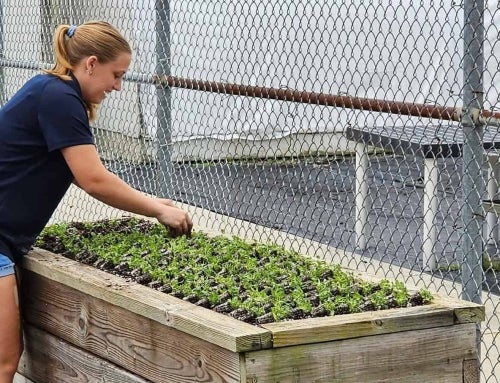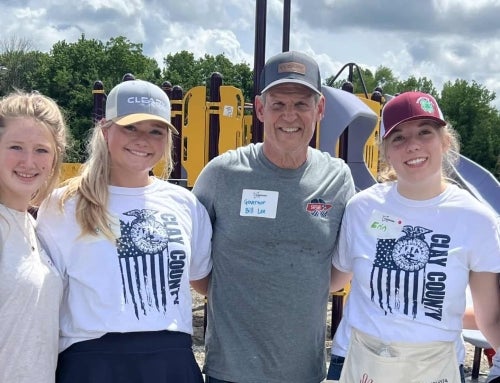When Monte Cummins saw Ryan Carpenter baling hay on his ranch, he offered to help. Although Cummins was only 8 years old – too small to move a hay bale or drive the four-wheeler – Carpenter welcomed the assistance.
“From then on, Monte would come and help no matter what we were doing,” Carpenter recalls. “If it was snowing or raining, if we were branding or feeding cows, Monte was there.”
Although agriculture is an important industry for the members of the Shoshone-Paiute Tribes who live on the Duck Valley Indian Reservation in Idaho and Nevada, Cummins didn’t grow up on a farm. Instead, he learned everything he knows about raising cattle from Carpenter.

Cummins shows a saddle in on the ranch.
“My dad used to work for a local ranch and I rode horses with him for a while, but I was interested in starting my own herd and trying to learn something new,” Cummins recalls. “I like to rope and ride, and I was always running around the community helping people.”
Community members noticed. Someone gifted him a horse and, almost every season, a grateful neighbor branded a heifer for Cummins, helping him build his own herd. Today, he ropes and rides, running his own 20-head herd of Black Angus-cross commercial cows across the wide-open plains in Nevada and Idaho.
“What I like about having my own herd is that I have the opportunity to make a bigger and better business for my future,” Cummins says.
Personal Growth Through FFA
Carpenter was a willing mentor. In addition to operating a cattle ranch, he is also the agriculture education instructor and FFA advisor at Owyhee High School in Owyhee, Nev. He recruited Cummins to join Duck Valley FFA when he started high school.
“Our chapter right now has almost a 100% native student population,” Carpenter says. “We’ve also had two state officers, including one who was the first native Nevada state president.”

Duck Valley FFA advisor Ryan Carpenter.
FFA has provided Cummins with numerous opportunities. He’s competed in the agriscience fair, participated in livestock judging and horse judging, and competed in an agriculture mechanics competition. Through FFA, he’s been able to travel throughout Nevada and meet other members with similar interests.
“Being in FFA helped me communicate with other people and learn the management side of the ranching business,” he says.
Cummins, now a senior, is his chapter’s president. He used his interest in cattle as inspiration for his supervised agricultural experience (SAE).
The SAE, he explains, required him to keep detailed records of his cattle operation, from the weights and colors of his branded heifers to their feed ratios and medicine doses.
Every fall, he decides which heifers to keep; he breeds them, sells most of his steers, and prepares for calving the following spring. Thanks to his relationships with other ranchers on the reservation, including Carpenter, he has help managing the herd and sells them through the same channels. The SAE, he explains, helped him determine the cost of running the operation and made him a better rancher.
“It helped me track the cattle and keep an eye on them better,” he explains.
For Carpenter, it’s gratifying to see FFA members embrace ranching and apply it to their studies.
“It’s very encouraging to see students like Monte who are happy to work hard in a very challenging business for the love of the life more than the money,” he says. “Some years are profitable and some are not, but kids like him just keep trying to make it work, and that is exactly what the agriculture industry needs to thrive.
“Ranching and cowboys and horses are a very culturally important part of this community,” Carpenter adds. “Millions of dollars come into this community through a handful of ranches every year, and most of that money stays right here.”
Learning an Old Craft

Cummins carves a leather coaster.
Working on the Walker-Carpenter Ranch, which Carpenter operates with his wife, also allowed Cummins to pursue another passion: leatherworking. Cummins learned the traditional craft from his dad. He started using leather to make coasters, carefully carving designs, stamping the leather and polishing the edges until each was a work of art.
In a shop on the ranch, Carpenter, a professional saddle- maker, encouraged Cummins to tackle larger projects. He makes headstalls for the horses, cutting the leather, gluing pieces together, shaping and stamping each one until perfect. Cummins has also made a belt, camera strap and several pairs of chaps, honing his technique.
“Anybody can learn leatherworking, but you have to really push yourself to try to achieve some of these things that Monte is doing,” Carpenter says. “He has a lot of natural creativity and talent.”
Carpenter, who is making Cummins a custom saddle as a graduation present, suspects there might come a time when his student takes over the shop, carrying on the tradition of making handcrafted leather saddles. In the meantime, Cummins continues to hone his skill and admits that turning scraps of leather into beautiful, functional pieces “feels kind of good.”

Mr. Carpenter details a leather coaster.
“A couple of times, I didn’t expect it to look as good as it did, and it just kind of motivates me to do a better job every time,” he says. “I get to use my creativity and it’s something I really enjoy doing.”
Although Cummins has sold his coasters and chaps, tucking the money into a checking account for his future, he admits that pursuing the traditional craft is about much more than earning an income.
“I think it’s very important to learn these skills so I can pass them on to the younger generation,” he says.
It’s also important to Cummins to continue running cattle and preserve the ranching tradition on the reservation. The knowledge he’s gaining through agriculture education classes, FFA activities and ongoing mentoring with Carpenter ensures that he’ll have the skills to run his own ranch and make his community proud.
“Honestly, I think it would have a really big effect on this community [if my generation didn’t carry on the ranching tradition] because our agricultural industry would just basically go downhill; there would be nobody to keep passing it on,” he says. “It’s important to keep this community in agriculture.”
For more information about SAEs, including ideas and inspiration, check out SAEForAll.org.











